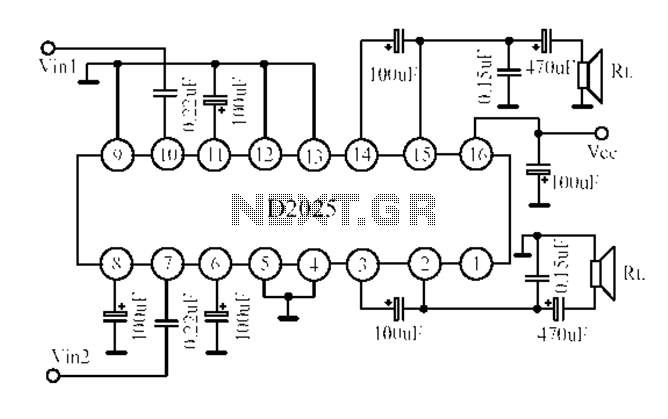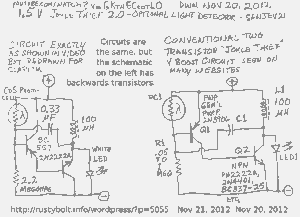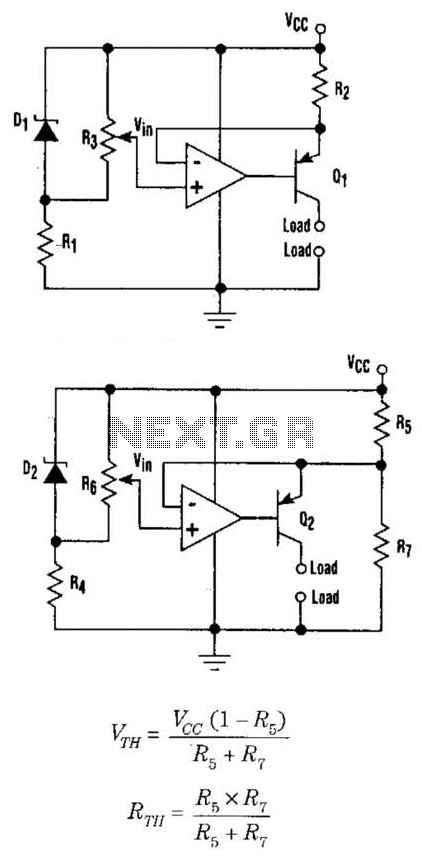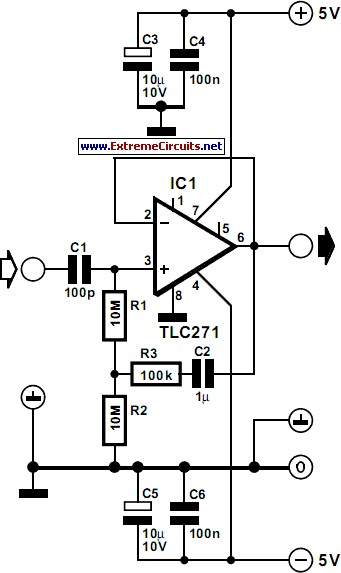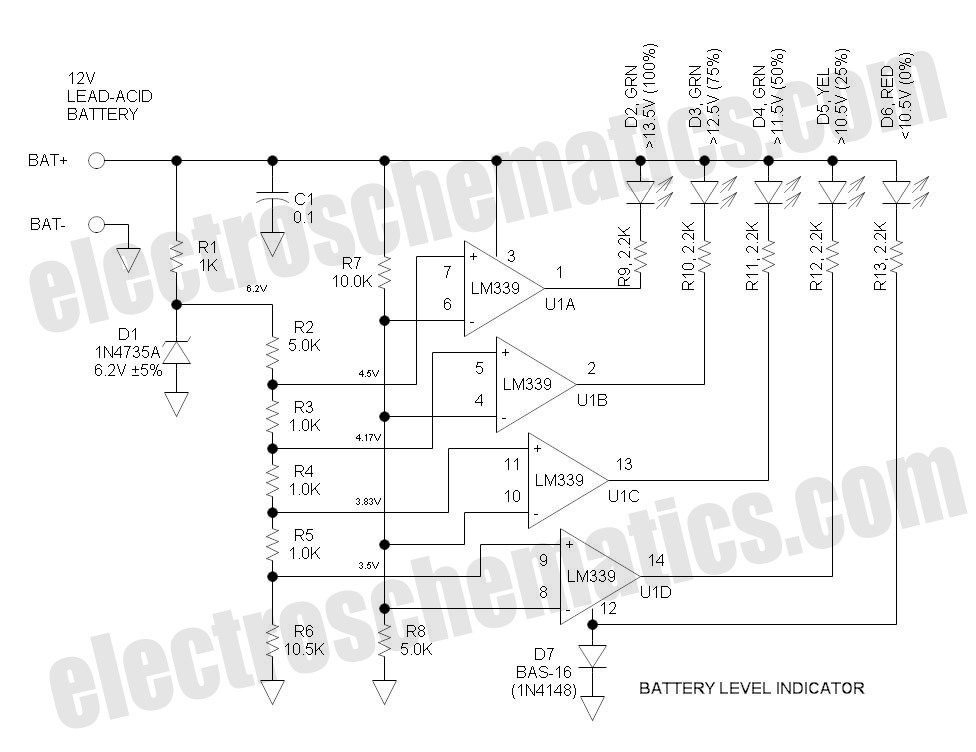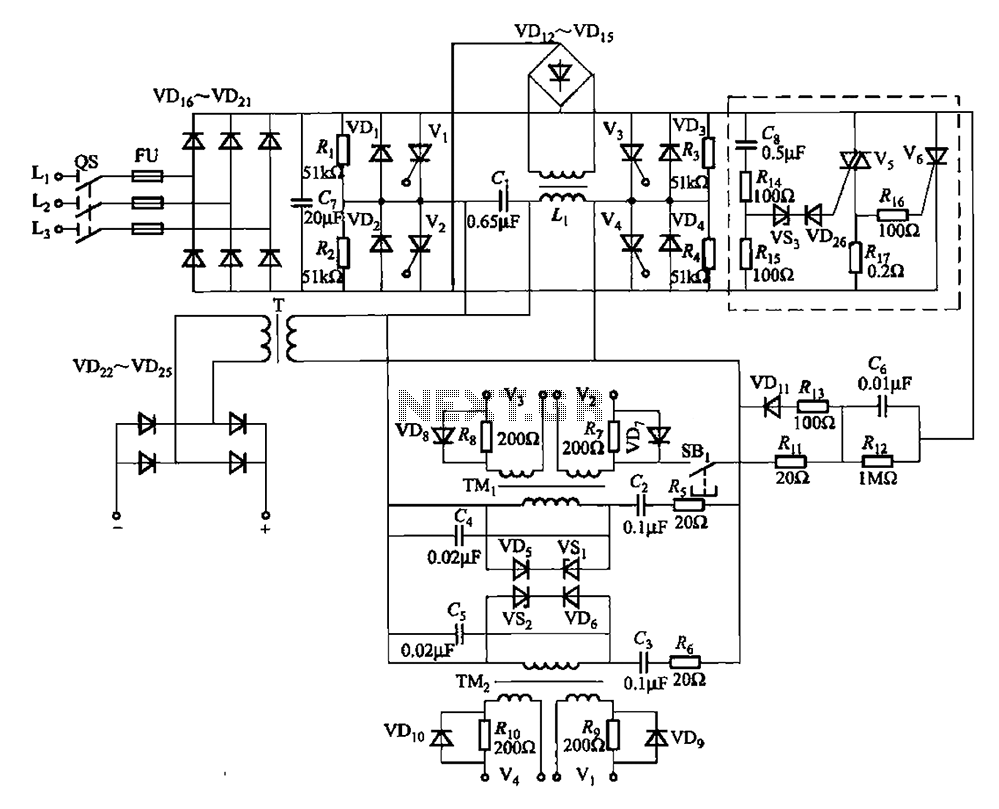
25 w stereo power amplifier circuit
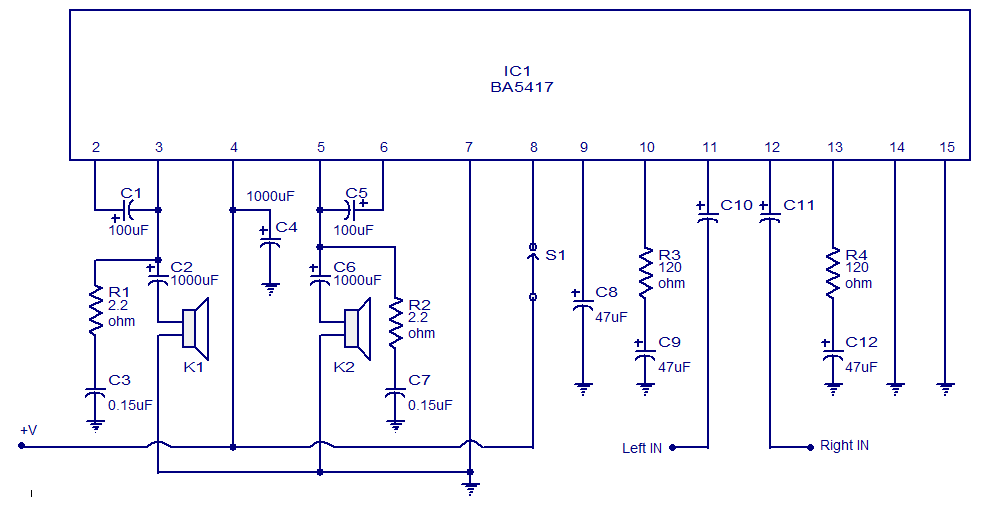
The BA5417 is a stereo amplifier integrated circuit (IC) that features several advantageous characteristics, including thermal shutdown, a standby function, soft clipping, and a wide operating voltage range. It can deliver 5 watts per channel into 4-ohm loudspeakers when powered by a 12V DC supply. The BA5417 is known for its excellent sound quality and low total harmonic distortion (THD) of approximately 0.1% at a frequency of 1 kHz and an output power of 0.5 watts. The setup and operation of this stereo power amplifier circuit are somewhat similar to the previously published BA5406-based stereo amplifier circuit. Capacitors C10 and C11 serve as DC decoupling capacitors, blocking any DC levels present in the input signals. Capacitors C2 and C6 couple the left and right power outputs of the amplifiers to the corresponding loudspeakers. Capacitors C1 and C5 are bootstrap capacitors used to enhance the input impedance of the amplifier by applying a portion of the amplifier's output to the input. The network consisting of resistors R1, capacitors C3, and resistors R2, C7 is designed to improve the high-frequency stability of the circuit. Capacitor C4 acts as a power supply filter capacitor, while switch S1 functions as the standby switch. Capacitor C8 is another filter capacitor. Resistors R3 and R4 set the gain of the left and right channels of the amplifier in conjunction with the internal feedback resistors of 39K.
The BA5417 stereo amplifier IC is designed to deliver high-quality audio performance with minimal distortion, making it suitable for various applications, including low-power car audio systems. The circuit's configuration allows for efficient amplification with a straightforward setup, as it requires very few external components. The inclusion of decoupling capacitors ensures that the input signals are free from DC offsets, thereby maintaining audio fidelity.
In addition to the BA5417, other stereo amplifier circuits such as the BA5406 and TDA1554 are mentioned, each with its unique specifications. The BA5406 can also deliver 5 watts per channel into 4-ohm speakers, operating from a 12V DC supply. The TDA1554 is a popular design capable of outputting 22 watts per channel into 4-ohm loudspeakers, while the TDA2050 circuit can provide 32 watts per channel with a dual supply of ±18V DC. The TDA4935 features overload protection and thermal shutdown, delivering 15 watts into 4-ohm speakers at a 24V DC operating voltage. Lastly, the LM4780 audio amplifier IC can produce 120 watts with a dual supply of ±35V DC, incorporating features such as good power supply rejection and built-in mute circuitry. Each of these designs showcases various configurations and capabilities, catering to different audio amplification needs.BA5417 is a stereo amplifier IC with a lot of good features like thermal shut down, standby function, soft clipping, wide operating voltage range etc. The IC can deliver 5W per channel into 4 ohm loud speakers at 12V DC supply voltage. The BA5417 has excellent sound quality and low THD (total harmonic distortion) around 0. 1% at F=1kHz; Pout=0. 5W. Setup and working of this stereo power amplifier circuit is somewhat similar to the BA5406 based stereo amplifier circuit published previously. C10 and C11 are DC decoupling capacitors which block any DC level present in the input signals. C2 and C6 couples the amplifiers left and right power outputs to the corresponding loud speakers. C1 and C5 are bootstrap capacitors. Bootstrapping is a method in which a portion of the amplifiers is taken and applied to the input. The prime objective of bootstrapping is to improve the input impedance. Networks R1, C3 and R2, C7 are meant for improving the high frequency stability of the circuit. C4 is the power supply filter capacitor. S1 is the standby switch. C8 is a filter capacitor. R3 and R4 sets the gain of the left and right channels of the amplifier in conjunction with the 39K internal feedback resistors.
BA5406 stereo amplifier circuit: Simple stereo amplifier circuit that can deliver 5 watt per channel sound output into a 4 ohm speaker. Operates from 12V DC and requires very few external components. Suitable for low power car audio applications. TDA1554 stereo amplifier circuit: A very popular stereo amplifier design. This amplifier can output 22 watts per channel into 4 ohm loud speakers. This circuit can be also powered from 12V DC. Low distortion and noise. 2G—32 watts stereo amplifier circuit: High quality stereo amplifier design using TDA2050 IC. The circuit requires a /-18V DC dual supply. Power output is 32 watts per channel into 4 ohm speakers. Stereo amplifier based on TDA4935: A stereo amplifier design with a lot of great features like over load protection and thermal shut down.
The power out put is 2G—15 W into 4 ohm speakers. Operating voltage is 24V DC. Potentiometers for controlling the volume is also included in the circuit. 120W stereo amplifier circuit: A powerful stereo amplifier design using LM4780 audio amplifier IC from National Semiconductors. operates from a /-35V DC dual power supply. 2G—60 watt power output into 8 ohm loud speakers. The circuit has good power supply rejection and also there is a built in mute circuitry. 🔗 External reference
The BA5417 stereo amplifier IC is designed to deliver high-quality audio performance with minimal distortion, making it suitable for various applications, including low-power car audio systems. The circuit's configuration allows for efficient amplification with a straightforward setup, as it requires very few external components. The inclusion of decoupling capacitors ensures that the input signals are free from DC offsets, thereby maintaining audio fidelity.
In addition to the BA5417, other stereo amplifier circuits such as the BA5406 and TDA1554 are mentioned, each with its unique specifications. The BA5406 can also deliver 5 watts per channel into 4-ohm speakers, operating from a 12V DC supply. The TDA1554 is a popular design capable of outputting 22 watts per channel into 4-ohm loudspeakers, while the TDA2050 circuit can provide 32 watts per channel with a dual supply of ±18V DC. The TDA4935 features overload protection and thermal shutdown, delivering 15 watts into 4-ohm speakers at a 24V DC operating voltage. Lastly, the LM4780 audio amplifier IC can produce 120 watts with a dual supply of ±35V DC, incorporating features such as good power supply rejection and built-in mute circuitry. Each of these designs showcases various configurations and capabilities, catering to different audio amplification needs.BA5417 is a stereo amplifier IC with a lot of good features like thermal shut down, standby function, soft clipping, wide operating voltage range etc. The IC can deliver 5W per channel into 4 ohm loud speakers at 12V DC supply voltage. The BA5417 has excellent sound quality and low THD (total harmonic distortion) around 0. 1% at F=1kHz; Pout=0. 5W. Setup and working of this stereo power amplifier circuit is somewhat similar to the BA5406 based stereo amplifier circuit published previously. C10 and C11 are DC decoupling capacitors which block any DC level present in the input signals. C2 and C6 couples the amplifiers left and right power outputs to the corresponding loud speakers. C1 and C5 are bootstrap capacitors. Bootstrapping is a method in which a portion of the amplifiers is taken and applied to the input. The prime objective of bootstrapping is to improve the input impedance. Networks R1, C3 and R2, C7 are meant for improving the high frequency stability of the circuit. C4 is the power supply filter capacitor. S1 is the standby switch. C8 is a filter capacitor. R3 and R4 sets the gain of the left and right channels of the amplifier in conjunction with the 39K internal feedback resistors.
BA5406 stereo amplifier circuit: Simple stereo amplifier circuit that can deliver 5 watt per channel sound output into a 4 ohm speaker. Operates from 12V DC and requires very few external components. Suitable for low power car audio applications. TDA1554 stereo amplifier circuit: A very popular stereo amplifier design. This amplifier can output 22 watts per channel into 4 ohm loud speakers. This circuit can be also powered from 12V DC. Low distortion and noise. 2G—32 watts stereo amplifier circuit: High quality stereo amplifier design using TDA2050 IC. The circuit requires a /-18V DC dual supply. Power output is 32 watts per channel into 4 ohm speakers. Stereo amplifier based on TDA4935: A stereo amplifier design with a lot of great features like over load protection and thermal shut down.
The power out put is 2G—15 W into 4 ohm speakers. Operating voltage is 24V DC. Potentiometers for controlling the volume is also included in the circuit. 120W stereo amplifier circuit: A powerful stereo amplifier design using LM4780 audio amplifier IC from National Semiconductors. operates from a /-35V DC dual power supply. 2G—60 watt power output into 8 ohm loud speakers. The circuit has good power supply rejection and also there is a built in mute circuitry. 🔗 External reference
